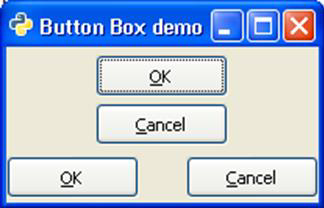
- PyGTK - Home
- PyGTK - Introduction
- PyGTK - Environment
- PyGTK - Hello World
- PyGTK - Important Classes
- PyGTK - Window Class
- PyGTK - Button Class
- PyGTK - Label CLass
- PyGTK - Entry Class
- PyGTK - Signal Handling
- PyGTK - Event Handling
- PyGTK - Containers
- PyGTK - Box Class
- PyGTK - ButtonBox Class
- PyGTK - Alignment Class
- PyGTK - EventBox Class
- PyGTK - Layout Class
- PyGTK - ComboBox Class
- PyGTK - ToggleButton Class
- PyGTK - CheckButton Class
- PyGTK - RadioButton Class
- PyGTK - MenuBar, Menu & MenuItem
- PyGTK - Toolbar Class
- PyGTK - Adjustment Class
- PyGTK - Range Class
- PyGTK - Scale Class
- PyGTK - Scrollbar Class
- PyGTK - Dialog Class
- PyGTK - MessageDialog Class
- PyGTK - AboutDialog Class
- PyGTK - Font Selection Dialog
- PyGTK - Color Selection Dialog
- PyGTK - File Chooser Dialog
- PyGTK - Notebook Class
- PyGTK - Frame Class
- PyGTK - AspectFrame Class
- PyGTK - TreeView Class
- PyGTK - Paned Class
- PyGTK - Statusbar Class
- PyGTK - ProgressBar Class
- PyGTK - Viewport Class
- PyGTK - Scrolledwindow Class
- PyGTK - Arrow Class
- PyGTK - Image Class
- PyGTK - DrawingArea Class
- PyGTK - SpinButton Class
- PyGTK - Calendar Class
- PyGTK - Clipboard Class
- PyGTK - Ruler Class
- PyGTK - Timeout
- PyGTK - Drag and Drop
PyGTK - ButtonBox Class
The ButtonBox class in gtk API serves as a base class for containers to hold multiple buttons either horizontally or vertically. Two subclasses HButtonBox and VButtonBox are derived from the ButtonBox class, which itself is a subclass of gtk.Box class.
A button box is used to provide a consistent layout of buttons throughout an application. It provides one default layout and a default spacing value that are persistent across all widgets.
The set_spacing() method of the gtk.Box class can be used to change the default spacing between buttons in the button box.
The default layout of buttons can be changed by the set_default() method. The possible values of the button layout are −
gtk.BUTTONBOX_SPREAD
gtk.BUTTONBOX_EDGE
gtk.BUTTONBOX_START
gtk.BUTTONBOX_END.
Example
In the following example, a VBox object inside the toplevel window internally contains one VButtonBox object and one HButtonBox object, each containing two buttons, arranged vertically and horizontally respectively.
Observe the code −
import gtk
class PyApp(gtk.Window):
def __init__(self):
super(PyApp, self).__init__()
self.set_title("Button Box demo")
self.set_size_request(200,100)
self.set_position(gtk.WIN_POS_CENTER)
vb = gtk.VBox()
box1 = gtk.VButtonBox()
btn1 = gtk.Button(stock = gtk.STOCK_OK)
btn2 = gtk.Button(stock = gtk.STOCK_CANCEL)
box1.pack_start(btn1, True, True, 0)
box1.pack_start(btn2, True, True, 0)
box1.set_border_width(5)
vb.add(box1)
box2 = gtk.HButtonBox()
btn3 = gtk.Button(stock = gtk.STOCK_OK)
btn4 = gtk.Button(stock = gtk.STOCK_CANCEL)
ent = gtk.Entry()
box2.pack_start(btn3, True, True, 0)
box2.pack_start(btn4, True, True, 0)
box1.set_border_width(5)
vb.add(box2)
self.add(vb)
self.show_all()
PyApp()
gtk.main()
The above code generates the following output −
